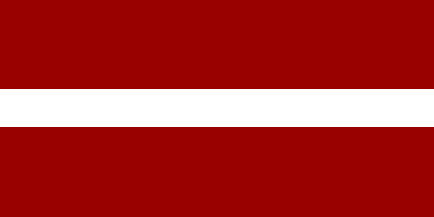|
Friday 2 September 2005
We take off on KLM
flight KL1323 from Schiphol Amsterdam Airport at 10.15am. We have about a
quarter of an hour's delay and t hat is why we do not land in Riga until 1.25pm.
Riga is on Eastern European Time and an hour ahead of the Netherlands. The
weather is fine, the sun is shining and it is about 20 degrees (68F). At the
airport we are greeted by a man waving a sign with my name on it. He escorts us
to a taxi waiting outside, gives the driver a note and we're off to Riga. We are
staying at the Radi un
Draugi hotel, in the centre of the old town, called Vecriga in
Latvian. After a short break we start on a walk through the old town. We start
at the Cathedral (Rigas Dome). It is a Lutheran Church originally built
in the 13th century on the initiative of the German priest Albert von Buxhoeveden,
the founder of Riga. The interior of the church is, as is customary with
Lutheran churches, rather austere. Most striking feature is the organ, which was
installed in 1884. The tombstones in the church are all in German. German was
the main language here for many centuries, as the city was founded by Germans
and became a German hanseatic town for many centuries. Across from the Cathedral
is the Stock Exchange, dating back to the 19th century with Greco-Roman
figures on its facade representing various industries and trades. We continue
and pass a building where once czar Peter the Great of Russia stayed and after
him Catharine the Great. Catherine's guard of honour was commanded by one Hieronymus Friedrich hat is why we do not land in Riga until 1.25pm.
Riga is on Eastern European Time and an hour ahead of the Netherlands. The
weather is fine, the sun is shining and it is about 20 degrees (68F). At the
airport we are greeted by a man waving a sign with my name on it. He escorts us
to a taxi waiting outside, gives the driver a note and we're off to Riga. We are
staying at the Radi un
Draugi hotel, in the centre of the old town, called Vecriga in
Latvian. After a short break we start on a walk through the old town. We start
at the Cathedral (Rigas Dome). It is a Lutheran Church originally built
in the 13th century on the initiative of the German priest Albert von Buxhoeveden,
the founder of Riga. The interior of the church is, as is customary with
Lutheran churches, rather austere. Most striking feature is the organ, which was
installed in 1884. The tombstones in the church are all in German. German was
the main language here for many centuries, as the city was founded by Germans
and became a German hanseatic town for many centuries. Across from the Cathedral
is the Stock Exchange, dating back to the 19th century with Greco-Roman
figures on its facade representing various industries and trades. We continue
and pass a building where once czar Peter the Great of Russia stayed and after
him Catharine the Great. Catherine's guard of honour was commanded by one Hieronymus Friedrich
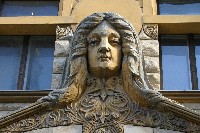 von
Münchhausen, the bogus baron who later became famous for his tales about his
impossible adventures. We then pass a beautiful Art Nouveau building, one of
many in Riga, but one of the few in the old town. Riga's Castle dates
back to the 15th century. This is a simple affair, but it does hold the Latvian
president's residence. There is an honour guard in front of the building. It was
once the head quarters of the Livonian Order of Knights, who for a long time
controlled Riga. Now, apart from the president, it houses 3 museums (Foreign
Art, Latvian History and Literature). On Maza Pils (Little Castle) Street von
Münchhausen, the bogus baron who later became famous for his tales about his
impossible adventures. We then pass a beautiful Art Nouveau building, one of
many in Riga, but one of the few in the old town. Riga's Castle dates
back to the 15th century. This is a simple affair, but it does hold the Latvian
president's residence. There is an honour guard in front of the building. It was
once the head quarters of the Livonian Order of Knights, who for a long time
controlled Riga. Now, apart from the president, it houses 3 museums (Foreign
Art, Latvian History and Literature). On Maza Pils (Little Castle) Street 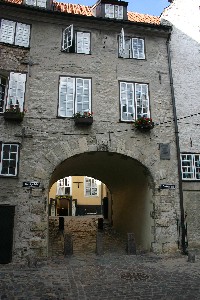 we see the Three Brothers. Three houses from different periods. The
oldest dates back to 1400 and seems to be tumbling over its neighbours. The
middle one is a fine renaissance house from the 17th century. The third, a
modest little thing is from a later date. Via Jekaba Street we pass the
Roman Catholic St James Church and the parliament. The parliament
building was built in the 19th century as a Knight's house and later served as
the communist headquarters during the revolutionary days of 1919 and as a
British embassy between the two world wars. We now pass a couple picturesque
streets like Torna iela, Troksnu iela and the Swedish Gate. This is the only
surviving city gate. Here is also the St James barracks, a 200 metre long yellow
coloured block. Once built by the Swedes as a barracks, it now hous
we see the Three Brothers. Three houses from different periods. The
oldest dates back to 1400 and seems to be tumbling over its neighbours. The
middle one is a fine renaissance house from the 17th century. The third, a
modest little thing is from a later date. Via Jekaba Street we pass the
Roman Catholic St James Church and the parliament. The parliament
building was built in the 19th century as a Knight's house and later served as
the communist headquarters during the revolutionary days of 1919 and as a
British embassy between the two world wars. We now pass a couple picturesque
streets like Torna iela, Troksnu iela and the Swedish Gate. This is the only
surviving city gate. Here is also the St James barracks, a 200 metre long yellow
coloured block. Once built by the Swedes as a barracks, it now hous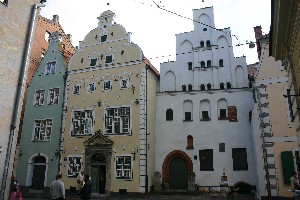 es
shops, café's and restaurants. When we arrive at the Powder Tower we stop the
walk for today. es
shops, café's and restaurants. When we arrive at the Powder Tower we stop the
walk for today.
We have a beer on Livu Laukums
square, full of side walk café's and beer gardens. I take a Latvian beer,
Aldaris, which is not bad at all.
In the evening we start
with a cocktail in the panoramic bar of Reval Hotel Latvija. This hotel, built
in the Soviet days, is located in the Centr district, just outside the old town.
On the 26th floor is the Skyline bar, with a marvelous view on the old town. The
ride up with the panoramic elevators is nice too.
Later at night we have
dinner at an outdoor restaurant (Velvets) in the old town near St Peter's
Church.
Saturday 3 September 2005
We have breakfast in
the hotel. After breakfast we start looking for a place to drink coffee, but
everything is still closed this time of day. The hotel café is open, however,
so that's fine. At 9.30 we are being met by Ivita Ose our guide for today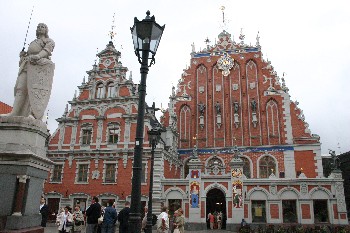 .
We have booked her via Patricija
Tourist Office. It is a young girl of 23, studying History at one of Riga's
universities. She first takes us through the old town, stopping at the House
of the Blackheads, a guild house, that was destroyed during the war, but
which has been rebuilt, in a bout of nationalism, after independence in 1991. It
looks nice, but very new. In front of the guild house is a statue for the Knight
Roland, the legendary hero who fought the Moors in the Pyrenees back
during the 9th century. Roland's legend was immensely popular in Northern Europe
and Riga honours him with a statue. Next to the Blackheads house is the museum
of the Latvian Occupation. According to Ivita it should be called Occupations
(plural!), because after the Russians in 1939, came the Germans in 1941 followed
again by the Russians until 1991. The building was originally dedicated to the
Latvian Riflemen. This was a Latvian regiment, founded by the Russians in
the war against Germany in 1915. The heroic regiment started to realize that it
was used as canon fodder by the Czarist army. They then turned against the
Russian army, thus contributing to .
We have booked her via Patricija
Tourist Office. It is a young girl of 23, studying History at one of Riga's
universities. She first takes us through the old town, stopping at the House
of the Blackheads, a guild house, that was destroyed during the war, but
which has been rebuilt, in a bout of nationalism, after independence in 1991. It
looks nice, but very new. In front of the guild house is a statue for the Knight
Roland, the legendary hero who fought the Moors in the Pyrenees back
during the 9th century. Roland's legend was immensely popular in Northern Europe
and Riga honours him with a statue. Next to the Blackheads house is the museum
of the Latvian Occupation. According to Ivita it should be called Occupations
(plural!), because after the Russians in 1939, came the Germans in 1941 followed
again by the Russians until 1991. The building was originally dedicated to the
Latvian Riflemen. This was a Latvian regiment, founded by the Russians in
the war against Germany in 1915. The heroic regiment started to realize that it
was used as canon fodder by the Czarist army. They then turned against the
Russian army, thus contributing to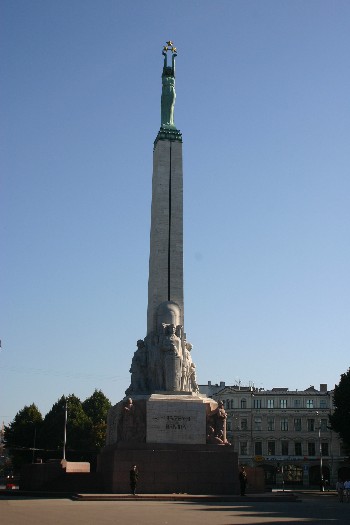 Lenin's communist take over of power in 1917. On the square the Riflemen are
commemorated with a red granite statue in Soviet style. We walk along the
Cathedral, which we saw yesterday, as well as the Swedish Gate before we leave
the old town and walk to the Freedom Monument. Built in the 1930s,
it is an allegorical statue with the words "For Fatherland and
Freedom". The 50 metre high column is crowned by a woman figure (Milda)
holding 3 stars in her hands. They are not Soviet stars, but represent the three
provinces of Latvia. There is a guard of honour in front of the statue.
Close to the monument we see the Laima-clock, sponsored by an named after a
chocolate manufacturer. The Art
Deco clock from the 1930s functions as a meeting place for many Rigans.
Lenin's communist take over of power in 1917. On the square the Riflemen are
commemorated with a red granite statue in Soviet style. We walk along the
Cathedral, which we saw yesterday, as well as the Swedish Gate before we leave
the old town and walk to the Freedom Monument. Built in the 1930s,
it is an allegorical statue with the words "For Fatherland and
Freedom". The 50 metre high column is crowned by a woman figure (Milda)
holding 3 stars in her hands. They are not Soviet stars, but represent the three
provinces of Latvia. There is a guard of honour in front of the statue.
Close to the monument we see the Laima-clock, sponsored by an named after a
chocolate manufacturer. The Art
Deco clock from the 1930s functions as a meeting place for many Rigans.
We walk along the
embassy buildings of Germany and France, beautifully located on the Raina
Boulevard. Eclectic buildings from the 19th century. Further on we get to the
Russian Orthodox Cathedral. We enter and witness a baptism in progress in one of
the chapels. But in the chapel across from it we see a dead man lying in state.
The only thing missing is a wedding in between! The cathedral was a planetarium
and café during the Soviet days, but has now been restored to its original
function. Latvia has a large Russian minority (in Riga even a majority of 55%),
who came here as a result of Stalin's industrialisation and migration policies
during the 1940s and 50s. During that time many Latvians were deported to
Siberia and other parts of the Soviet Union. Active knowledge of the Latvian
language is now a requirement for Latvian citizenship, something the ethnic
Russian do not possess. We continue and arrive at the Berga Bazars a
complex of buildings bought and redeveloped by the Latvian real estate developer Bergs,
a "rags to riches" type of man. He has not done a bad job at all
with this part of town. We then walk to the Central Market (Centraltirgus). This
is located in 5 huge halls behind the Central Railway Station, which once served
as hangars for Zeppelins. The Art Deco halls are incredibly high and spacious
and contain stalls with all kinds of fresh food: Vegetables, fruit, meat, live
fish (!) and also lots of dried fish. Dried fish appears to be a favorite beer
snack for the Russians. Russian is the main language at the market. Contrary
what the merchants want us to believe, a lot of the merchandise is Mediterranean
rather the domestic produce.
of buildings bought and redeveloped by the Latvian real estate developer Bergs,
a "rags to riches" type of man. He has not done a bad job at all
with this part of town. We then walk to the Central Market (Centraltirgus). This
is located in 5 huge halls behind the Central Railway Station, which once served
as hangars for Zeppelins. The Art Deco halls are incredibly high and spacious
and contain stalls with all kinds of fresh food: Vegetables, fruit, meat, live
fish (!) and also lots of dried fish. Dried fish appears to be a favorite beer
snack for the Russians. Russian is the main language at the market. Contrary
what the merchants want us to believe, a lot of the merchandise is Mediterranean
rather the domestic produce.
Finally we head for the
part of the Centr District (not to be confused with the old town) where most of
the Art Nouveau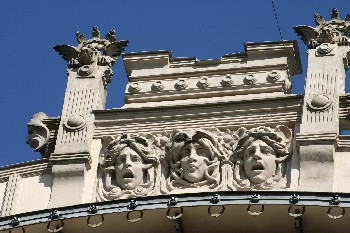 architecture can be found. Alberta street exist of nothing but Art Nouveau, all
from the early 20th century. An impressive collection of richly decorated
buildings. A unique sight to see a street with all buildings in one particular
style and period. In the communist times the houses were communal, that
is, numerous families shared communal facilities. Now they have been converted
into apartments. One them houses the Belgian embassy. On the corner of Alberta
Street and Strelniekustra we see
architecture can be found. Alberta street exist of nothing but Art Nouveau, all
from the early 20th century. An impressive collection of richly decorated
buildings. A unique sight to see a street with all buildings in one particular
style and period. In the communist times the houses were communal, that
is, numerous families shared communal facilities. Now they have been converted
into apartments. One them houses the Belgian embassy. On the corner of Alberta
Street and Strelniekustra we see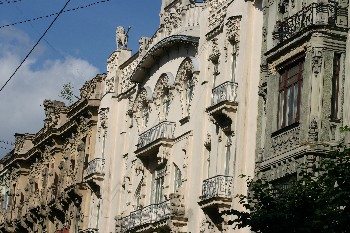 the Rozentals/Blaumanis
Museum. Once the Latvian painter Rozentals and the writer Blaumanis lived here.
The interior is open for visitors and is, just like the outside, in Art Nouveau
style. After 3 hours we say goodbye to Ivita and go for lunch in the Flying Frog
(Lidojosa Varde). Simple café
style food.
the Rozentals/Blaumanis
Museum. Once the Latvian painter Rozentals and the writer Blaumanis lived here.
The interior is open for visitors and is, just like the outside, in Art Nouveau
style. After 3 hours we say goodbye to Ivita and go for lunch in the Flying Frog
(Lidojosa Varde). Simple café
style food.
In the afternoon we
take bus #40 which takes us from Raina Bulvaris to the Salu bridge across the Daugava
River. We alight half way down the bridge and walk south over the Zakusala (Rabbit
Island) via a deserted road to the TV tower for a marvelous view of the city.
The viewing platform is located at 97 metres. For a mere 2 Lat 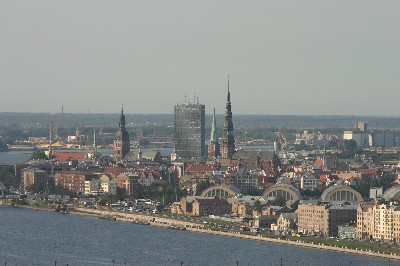 (€3 euro) we can take the elevator up. Back in town we take a look in the Stockmann
department store (a Finnish company), where we find only luxury goods, well out
of reach for many Latvian wallets. At night we drink a cocktail with
Black Balsam, the typical Latvian concoction. In coctail shape it is just about
bearable, pure would probably be too Latvian.
(€3 euro) we can take the elevator up. Back in town we take a look in the Stockmann
department store (a Finnish company), where we find only luxury goods, well out
of reach for many Latvian wallets. At night we drink a cocktail with
Black Balsam, the typical Latvian concoction. In coctail shape it is just about
bearable, pure would probably be too Latvian.
We eat at Salt 'n
Pepper. The food is reasonable, but on the spicy side.
After dinner we head
for club XXL, one of two gay clubs in
Riga. After 11pm it fills up with a relatively young male crowd. We stay around
until 1am.
The Riga's old town is very noisy on a Saturday night. Not least because
of the groups of boisterous (mostly British) male tourists out on all night pub
crawl. Apparently Riga is becoming the next relatively cheap target (after
Amsterdam, Antwerp and Prague) for these kind of weekend trips
Sunday 4 september 2005
We continue our walk we
started on Friday. The walk takes us to the Great and the Small Guild. The 15th
century buildings belonged to the guilds  of
the merchant elite, only accessible for Germans. The Latvians had to make do
with the guilds for fishermen and boatsmen. The Small Guild is especially
pretty with a statue of St John on its corner. It bit further down is the House
of the Cat. The owner had been refused membership at the beginning of the 20th
century, because he was Latvian. As an angry response he put up a statue of a
cat on the roof of his Art Nouveau house. The cat showed it rear towards the
Guilds. After a court case the cat had to be turned round. We then walk to the
St John's church. According to legend two monks were immured in the southern
facade. They were kept alive with food delivered through a hole in the wall. A
piece of medieval devotion, not uncommon in those days. Now the church is the
venue for organ concerts. Next to it is the St Peter's Church with its
characteristic onion s of
the merchant elite, only accessible for Germans. The Latvians had to make do
with the guilds for fishermen and boatsmen. The Small Guild is especially
pretty with a statue of St John on its corner. It bit further down is the House
of the Cat. The owner had been refused membership at the beginning of the 20th
century, because he was Latvian. As an angry response he put up a statue of a
cat on the roof of his Art Nouveau house. The cat showed it rear towards the
Guilds. After a court case the cat had to be turned round. We then walk to the
St John's church. According to legend two monks were immured in the southern
facade. They were kept alive with food delivered through a hole in the wall. A
piece of medieval devotion, not uncommon in those days. Now the church is the
venue for organ concerts. Next to it is the St Peter's Church with its
characteristic onion s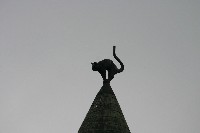 haped
steeple. It is not the first steeple, but a replica of the 18th century version
of it. The tower was shot to pieces by the Germans in 1941. An elevator takes
us up to a 79 metre high viewing platform for 2 Lats per person. haped
steeple. It is not the first steeple, but a replica of the 18th century version
of it. The tower was shot to pieces by the Germans in 1941. An elevator takes
us up to a 79 metre high viewing platform for 2 Lats per person.
We cross the Daugava to visit the Pardaugava district. After a long walk along
the Uzvaras Bulvaris, passing the park with the same name and the Soviet war
memorial we reach the covered market Agenskalns. This market really is off the
beaten tourist track and the domain of working class Rigans. The stalls offer
cheap clothing, shoes and lots of meat, fish and vegetables. We eat a small
snack for almost nothing and walk back via Smilga Street. This street is lined
with wooden houses, which are so typical for Pardaugava. Many of them are in bad
repair. Finally we reach the Vansu Tilts, 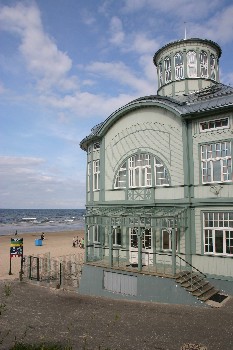 the
big futuristic suspension bridge over the Daugava which leads us back to the old
town. We have lunch and take the 2pm train to Jurmala. The train journey in the
old fashioned and crackling train carriages takes about 35 minutes (from
platform 3 or 4, every half hour). The station names along the way are not too
clearly marked, but fortunately a map of the railnetwork is posted on the
carriage walls. The ticket inspector is very active in checking tickets but does
not speak any foreign language (apart from Russian). Jurmala or "seashore"
is a series of small seaside resorts West of Riga, on the Gulf of Riga.
We get out at Majori. This is the most developed village with lots of
restaurants and shops along the Jomas street towards neighbouring Dzintari.
We stroll along the beach to Dzintari, have a drink at a beach café and
return via Jomas to Majori. On this sunny Sunday all the sideway café's are
filled to capacity. We take the 4.23 service back to Riga. the
big futuristic suspension bridge over the Daugava which leads us back to the old
town. We have lunch and take the 2pm train to Jurmala. The train journey in the
old fashioned and crackling train carriages takes about 35 minutes (from
platform 3 or 4, every half hour). The station names along the way are not too
clearly marked, but fortunately a map of the railnetwork is posted on the
carriage walls. The ticket inspector is very active in checking tickets but does
not speak any foreign language (apart from Russian). Jurmala or "seashore"
is a series of small seaside resorts West of Riga, on the Gulf of Riga.
We get out at Majori. This is the most developed village with lots of
restaurants and shops along the Jomas street towards neighbouring Dzintari.
We stroll along the beach to Dzintari, have a drink at a beach café and
return via Jomas to Majori. On this sunny Sunday all the sideway café's are
filled to capacity. We take the 4.23 service back to Riga.
Later in the early
evening we have a cocktail at Spalvas pa gaisu. Nice enough place in the old
town with a young crowd. Shame though that they are short staffed and have
set up a large video screen showing an ice hockey match. After the drinks we
head for Melnie Muki (Black Monk) for dinner. The restaurant is based in an old
house with medieval walls. The menu is incredibly extensive and varied. The food
is good, apart from a few items. The Spanish wine is great too. In our hotel we
take a night cap in the guest lounge. .
Monday
5 September 2005
We sleep late. After
breakfast we walk through the city parks separating the old town from the Centr district. The weather is great and the benches are full of relaxing
people. . The City Park and the Kronvaldspark are situated along the old city
moat Pilsetas Kanals. In the park we also see the remnants of an old bastion.
Along the park runs Raiņa Bulvāris, a busy street with numerous
impressive city palaces in which a number of embassies are based (France,
Germany, USA). Further on we find the parks Esplanāde and Vērmane’s
garden, with the Russian Orthodox cathedral. We were here on Saturday already.
We do some shopping and slowly but surely head back towards the hotel. At 11.30
we have our airport transfer. It is a short 15 minute's drive. We eat a bit and
wait for the flight's departure at 1.55pm. Around 3.10pm we land at
Schiphol Amsterdam Airport. Our train to Rotterdam leaves a 3.40 and about an
hour later we back home in Rotterdam.
district. The weather is great and the benches are full of relaxing
people. . The City Park and the Kronvaldspark are situated along the old city
moat Pilsetas Kanals. In the park we also see the remnants of an old bastion.
Along the park runs Raiņa Bulvāris, a busy street with numerous
impressive city palaces in which a number of embassies are based (France,
Germany, USA). Further on we find the parks Esplanāde and Vērmane’s
garden, with the Russian Orthodox cathedral. We were here on Saturday already.
We do some shopping and slowly but surely head back towards the hotel. At 11.30
we have our airport transfer. It is a short 15 minute's drive. We eat a bit and
wait for the flight's departure at 1.55pm. Around 3.10pm we land at
Schiphol Amsterdam Airport. Our train to Rotterdam leaves a 3.40 and about an
hour later we back home in Rotterdam.
|
